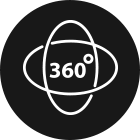Dose levels in the vicinity
μSv/h
What is this facility?
Multi-nuclide removal equipment (ALPS) is equipment dedicated to remove radioactive materials contained in contaminated water excluding tritium having ability to reduce the concentrations of radioactive substances to levels that meet government’s regulations certainly.
It can remove 62 types of radioactive materials through chemical agent-induced precipitation and multiple adsorbent.
See the Treated Water Portal Site for more detail.
Note on “Water treated with multi-nuclide removal equipment etc. (ALPS treated water)” is notated.
"ALPS treated water" refers to water that has been purified with multi-nuclide removal equipment (ALPS), etc. until the concentrations of radioactive substances, excluding tritium, meet the government’s regulatory standards (The sum of the ratio of legally required concentrations, excluding tritium, being less than 1).
Water that has been purified with multi-nuclide removal equipment (ALPS), etc., but has yet to fulfill the government’s regulatory standards (The sum of the ratio of legally required concentrations, excluding tritium, being 1 or higher) is referred to as, "treated water to be re-purified".
When referring to both of the aforementioned types of treated water collectively, "ALPS treated water, etc." is used.
What is tritium?
Tritium is a relative of hydrogen that bonds with oxygen just like other hydrogen and exists as a liquid that has almost the same qualities as water.
The energy of radiation emitted by tritium is extremely weak and can travel only approximately 5mm through the air. It can be shielded with a single sheet of paper.
Tritium occurs naturally in the environment when radiation from space falls to the Earth in the form of "cosmic rays" and mixes with our atmosphere.
Tritium is also generated through the process of nuclear fission at nuclear facilities in Japan and overseas. Tritium is present in rain water, seawater, and tap water, and can be found inside the bodies of humans and animals. Click here for more information on tritium.
*Tritium generated at nuclear power facilities is regulated and managed in accordance with each country's requirements and discharged into the sea and atmosphere, etc.
What protective equipment do workers wear in this area?
This is an area for treating contaminated water so workers wear protective clothing and full-face masks.
How much contaminated water can the equipment treat per day?
The entire multi-nuclide removal equipment can treat a maximum of approximately 2,000 tons of contaminated water per day.







